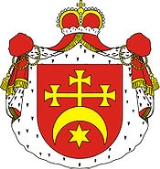
Michal Wisniowiecki
Encyclopedia
| Michał Wiśniowiecki | |
| EWLINE image goes here |
|
| Noble Family Szlachta The szlachta was a legally privileged noble class with origins in the Kingdom of Poland. It gained considerable institutional privileges during the 1333-1370 reign of Casimir the Great. In 1413, following a series of tentative personal unions between the Grand Duchy of Lithuania and the Kingdom of... |
Wiśniowiecki Wisniowiecki Wiśniowiecki is the name of a family notable in the history of Polish-Lithuanian Commonwealth. They were powerful magnates in Ruthenia of Rurikid or Gediminids descent. The family traditions traces their descend to Gediminids, but modern historians believe there is more evidence for the Rurikid... |
| Coat of Arms Polish heraldry Polish heraldry is a branch of heraldry focused on studying the development of coats of arms in the lands of historical Poland , as well as specifically-Polish traits of heraldry. The term is also used to refer to Polish heraldic system, as opposed to systems used elsewhere, notably in Western Europe... |
Korybut |
| Parents | Michał Wiśniowiecki Halszka Zenowiczówna |
| Consorts | Regina Mohyła |
| Children | Jeremi Michał Wiśniowiecki Anna Wiśniowiecka |
| Date of Birth | ? |
| Place of Birth | ? |
| Date of Death | 1616 |
| Place of Death | ? |
Michał Wiśniowiecki (died 1616) was a Polish-Lithuanian Commonwealth
Polish-Lithuanian Commonwealth
The Polish–Lithuanian Commonwealth was a dualistic state of Poland and Lithuania ruled by a common monarch. It was the largest and one of the most populous countries of 16th- and 17th‑century Europe with some and a multi-ethnic population of 11 million at its peak in the early 17th century...
szlachcic, prince
Prince
Prince is a general term for a ruler, monarch or member of a monarch's or former monarch's family, and is a hereditary title in the nobility of some European states. The feminine equivalent is a princess...
at Wiśniowiec, magnate
Magnate
Magnate, from the Late Latin magnas, a great man, itself from Latin magnus 'great', designates a noble or other man in a high social position, by birth, wealth or other qualities...
, grandfather of future Polish-Lithuanian Commonwealth
Polish-Lithuanian Commonwealth
The Polish–Lithuanian Commonwealth was a dualistic state of Poland and Lithuania ruled by a common monarch. It was the largest and one of the most populous countries of 16th- and 17th‑century Europe with some and a multi-ethnic population of 11 million at its peak in the early 17th century...
monarch
Monarch
A monarch is the person who heads a monarchy. This is a form of government in which a state or polity is ruled or controlled by an individual who typically inherits the throne by birth and occasionally rules for life or until abdication...
, Michał Korybut Wiśniowiecki. Starosta
Starosta
Starost is a title for an official or unofficial position of leadership that has been used in various contexts through most of Slavic history. It can be translated as "elder"...
owrucki.
Took part in the Magnate wars in Moldavia, supported False Dmitriy I
False Dmitriy I
False Dmitriy I was the Tsar of Russia from 21 July 1605 until his death on 17 May 1606 under the name of Dimitriy Ioannovich . He is sometimes referred to under the usurped title of Dmitriy II...
and False Dmitriy II during the Muscovite Time of Troubles
Time of Troubles
The Time of Troubles was a period of Russian history comprising the years of interregnum between the death of the last Russian Tsar of the Rurik Dynasty, Feodor Ivanovich, in 1598, and the establishment of the Romanov Dynasty in 1613. In 1601-1603, Russia suffered a famine that killed one-third...
and the Polish–Muscovite War (1605–1618).

Konstanty Wisniowiecki
Prince Konstanty Wiśniowiecki , Wojewoda Belski 1636, Wojewoda Ruski 1638, and Starosta Czerkaski i Kamionecki was a wealthy, powerful and influential magnate, experienced in both politics and warfare....
and eventually became a powerful magnate, one of the most famous members of the Wiśniowiecki family. His daughter Anna Wiśniowiecka was a potential marriage candidate to king Władysław IV Waza in 1636. Although Władysław was quite supportive of the marriage, it was blocked by the Sejm
Sejm
The Sejm is the lower house of the Polish parliament. The Sejm is made up of 460 deputies, or Poseł in Polish . It is elected by universal ballot and is presided over by a speaker called the Marshal of the Sejm ....
. Anna eventually married Zbigniew Firlej
Zbigniew Firlej
Zbigniew Firlej , of Lewart coat of arms, was a noble of the Polish-Lithuanian Commonwealth. Starost of Lublin. Son of Mikołaj Firlej and Regina Oleśnicka. Married to Anna Wiśniowiecka, daughter of Michał Wiśniowiecki ; and to Katarzyna Opalińska, daughter of Łukasz Opaliński, in 1647....
between 1636 and 1638.

